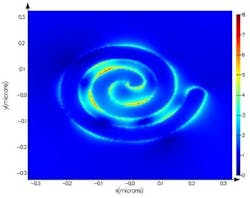Gold nanospirals frequency-double light, can serve as anticounterfeiting devices
Gold nanospirals with a plasmonic geometry can frequency-double ultrafast laser pulses, researchers have found. The team, which has members from Vanderbilt University (Nashville, TN), Cornell University (Ithaca, NY), and Pacific Northwest National Laboratory (Richland, WA), designed the spirals with an Archimedean shape (distance from center is a linear function of radius) and illuminated them with 15 fs pulses of 800 nm near-infrared light from a titanium:sapphire (Ti:sapphire) ultrafast laser to produce 400 nm (blue) light.1
The light actually drives electrons from the edge of the spiral towards the center to produce the second harmonic generation (SHG); as a result, when left-handed nanospirals are illuminated with clockwise circularly polarized light, which pushes the electrons toward the center of the spiral, the second-harmonic generation efficiency is much higher than for counterclockwise circularly polarized light, which drives electrons to the outer edge of the spiral.
For linearly polarized light, the amount of blue light the nanospirals emit varies as the angle of the plane of polarization is rotated through 360°.
Anticounterfeiting uses
In one potential use, the nanospirals could be embedded in banknotes, credit cards, ID cards, or important documents to deter counterfeiting. The combination of the unique characteristics of the frequency doubling by the specific size and geometry of the nanospirals and their response to polarized light result in a unique, customizable signature that would be extremely difficult to counterfeit, say the researchers.
The nanospirals, which are uncoated gold and are formed using electron-beam lithography, can each handle much as 300 μW of near-IR light. Because the SHG is not a function of the way the spirals are arranged, they can be scattered randomly across an area.
REFERENCE:
1. Roderick B. Davidson II et al., Nanophotonics (2015); doi: 10.1515/nanoph-2015-0002
Source: http://news.vanderbilt.edu/2015/06/worlds-smallest-spirals-could-guard-against-identity-theft/
This article was originally published on 6/3/2015
About the Author
John Wallace
Senior Technical Editor (1998-2022)
John Wallace was with Laser Focus World for nearly 25 years, retiring in late June 2022. He obtained a bachelor's degree in mechanical engineering and physics at Rutgers University and a master's in optical engineering at the University of Rochester. Before becoming an editor, John worked as an engineer at RCA, Exxon, Eastman Kodak, and GCA Corporation.

